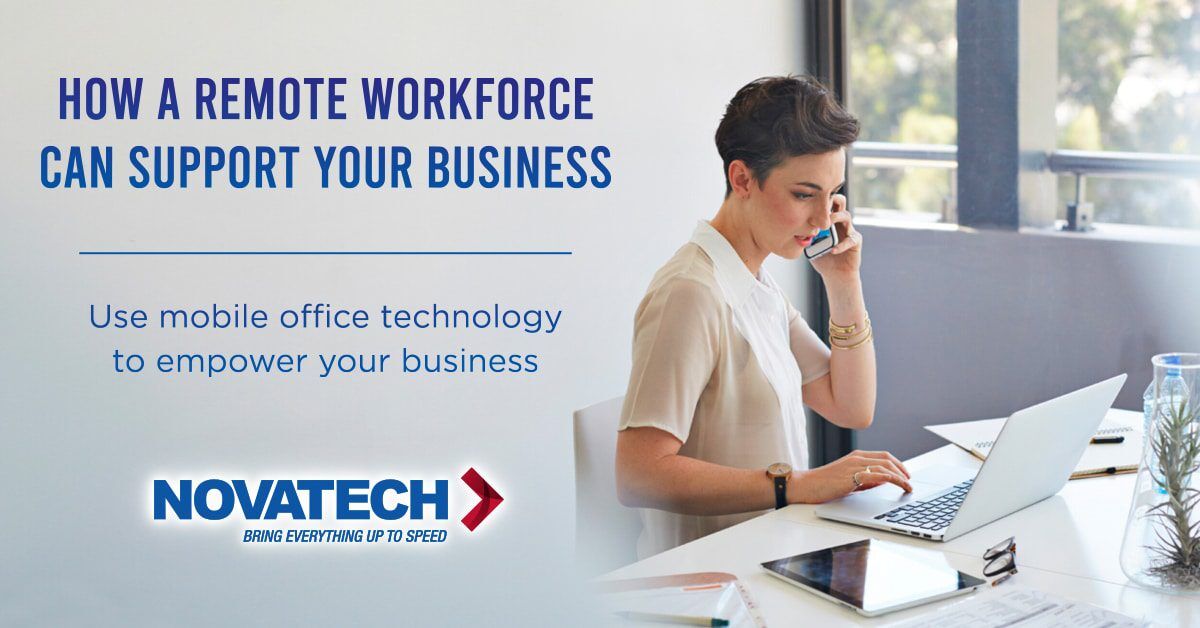Empower your remote workforce with mobile office technology
4 min read

Karen Gilleland
You probably know at least a few friends working from home these days. The trend is on the upswing, despite what headlines about companies pulling employees back into the office may suggest. Survey guru Gallup swizzled the numbers and found 43 percent of American workers were already part of the remote workforce, a number expected to hit 50 percent by 2020.
It’s thanks to mobile office technology that this swing toward offices without borders is even happening. Former desk jockeys are tapping into smartphones and laptops to access email, group chat apps, remote printing, instant messaging, screen and file sharing, videoconferencing, and VPNs—all from their kitchen tables or their beach houses.
Mobile office technology makes for happy workers
What’s bubbling to the surface as a result of this shift? Remote workers are feeling more valued, engaged, and empowered. A report assembled by GlobalWorkplaceAnalytics.com sets out a plethora of stats, including these gems:
- 36 percent of employees would choose working from home over a pay raise
- 95 percent of employers say telework improves employee retention
- 80 percent of employees consider remote work a job perk
Meanwhile, employers are saving money on overhead while widening their pool of potential hires. These benefits don’t even take into account environmental bonuses that could come from unclogging the highways. What’s more, the pajama brigade is surprising cynics with an uptick in business metrics, including 30 percent better processes and 23 percent more productivity. Not only does remote work make employees happier, but it actually works for the business—and the planet, too.
Before you start questioning why anyone bothers with offices anymore, though, there are a few potential drawbacks you’ll need to account for when enabling your remote workforce.
Consider the interpersonal factor
You’d think employees would slack off when working in their beds every day, but the opposite is often the case in reality. Without a clear delineation between work and home, they may skip meals, work full blast from dawn ’til dust, and check email in the middle of the night. That’s a fast track to burnout. To counter that behavior, Jason Fried, Basecamp CEO, suggests business leaders, “Preach breaks, lunch hours, and in general, self-control to ensure your team stays productive and healthy.”
There’s also the social factor of work to consider. Even the most fervent remote workers can get lonely in the backyard with only the peonies to applaud their latest great idea. People miss hanging out and laughing with colleagues. If you’re serious about remote work, collaboration technologies that encourage group chatting and clarify communication channels are a must to help people feel like they’re part of the team.
Meeting up at team picnics, staff retreats, or company-wide rallies is essential for any “company without walls.” These events can generate camaraderie, inform employees about the state of the business, and pump up buy-in to the company’s goals and vision. You can chalk off the investment in speakers, hotels, and meals against the savings you’re pocketing in real estate and overhead.
Update your infrastructure for a mobile world
Of course, you don’t want to simply cram old desktop processes onto mobile tech. Introducing mobile office technology is a golden opportunity to revamp and streamline your processes for greater efficiency. Cloud software, online document drives, and collaboration tools, for instance, makes things easier on mobile workers while streamlining how your business operates in general. Even something simple, like making mobile printing easier, will empower your employees to get more done faster.
Security can give pause to any organization interested in a mobile workforce, especially in light of a UK study that found:
- Only 12 percent of remote workers faithfully adhere to basic cybersecurity practices
- 17 percent have no anti-virus protection
- 12 percent use the same password on home and work devices
Face it: Security is a headache no matter where your business carries out its operations. Ultimately, though, the benefits of a remote workforce outweigh the risks. Instead of locking things down and forbidding employees to work outside the office, prepare for mobility with some strategic security initiatives. These could include requiring two-factor authentication to access company data, implementing mobile device management software, partnering with an MPS provider for more secure mobile printing, and restricting which mobile apps can be downloaded.
Support a remote workforce to support your business
There are a few challenges to meet before introducing mobile office technology, but it’s worth the effort to meet them. The increased happiness and productivity employees will experience as a result will help you grow your business in the long run.
As long as you do your due diligence by introducing technology that makes it easier to communicate, collaborate, and remain secure, you’ll join the ranks of organizations touting the delights of a mobile workforce.
Contact the Novatech team to discuss a plan to enpower your remote workforce today: Novatech.net
Novatech is a proud Partner First Managed Print Specialist



